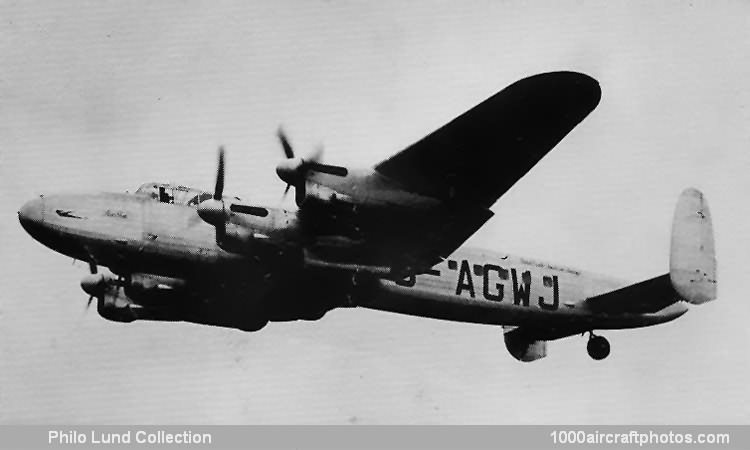01/31/2013. Remarks by Johan Visschedijk: "Unlike the York, which had a spacious fuselage of new design, the Lancastrian was simply a demilitarized Lancaster fitted with nose and tail cones in place of the turrets. The first conversion was made to the designs of Trans-Canada Air Lines (TCA) who were quick to realize the potentialities of the famous bomber as a Transatlantic transport. A Canadian Lancaster CF-CMS was flown to England for prototype conversion and inaugurated the service on July 22, 1943 by carrying four tons of Canadian Forces' mail non-stop from Dorval to Prestwick in the record time of 12 hr 26 min. This record was repeatedly broken in the following years by the fleet of eight TCA Lancastrians.
In all 91 Lancastrians were produced to RAF and civil orders, thirty of these were converted from Lancaster bombers, 61 were newly built. The first of the British civil Lancastrians was G-AGLF converted from Lancaster VB873 and handed over to the BOAC Development Flight at Hurn with a CofA issued on February 7, 1945. The record-breaking flight two months later by Captain R.G. Buck in this machine to New Zealand in three and a half days, heavily underlined the end of the leisurely pre-war Empire Air Route schedules. During its relatively short service life the Lancastrian created an entirely new conception of this subject.
From the tail end of Lancaster production, 32 aircraft were earmarked for BOAC, but only twenty were converted, the last being delivered in October 1945. Their markings were G-AGLS to G-AGMM (less G-AGMI). They were for joint use with QANTAS on the Kangaroo service, British crews being relieved by Australians at Karachi. The inaugural service left Hurn on May 31, 1945 piloted by Captain E. Palmer in G-AGLV, the QANTAS service leaving Sydney in G-AGLS on June 2. Lancastrians were far from economical in operation, only nine passengers being carried in a row of seats facing inwards along the port side, but they were an acknowledged post-war interim type and against the annual loss on the Kangaroo service could be offset the prestige value of their fast three-day schedule to Sydney.
It had long been a British ambition to operate to South America, but no British commercial type prior to the Lancastrian had enough range for the South Atlantic crossing. The honor of making the first survey flight fell to Captain O.P. Jones, who left Hurn in G-AGMG on October 9, 1945 en route to Buenos Aires and over the Andes to Santiago and Lima. Regular services were opened with a fleet of six thirteen-passenger Lancastrian 3s G-AGWG to G-AGWL by British South American Airways Corporation (BSAAC) in the following year. Twelve more Lancastrian 3s G-AHBT to G-AHCE, built at Woodford, were delivered at the end of 1946, three for the newly formed Silver City Airways and four for Skyways Ltd.
The remaining five were sold by BOAC to the Italian airline Alitalia, in which it had a financial interest. The others were used on long-distance charters to South Africa, Australia and the Far East. Eight former RAF C.Mk.4s, distinguished by their extra windows, were acquired by Skyways Ltd. in 1947-1948, two of these being sold to BSAAC, and three more helping BOAC over the fleet shortage caused by the withdrawal of the Tudors. Four of the earlier Lancastrians were sold to QANTAS, and in 1949 Skyways operated the Nairobi-Mauritius-Réunion shuttle on behalf of BOAC with G-AGLV reregistered VP-KGT for the purpose.
In its declining years the Lancastrian gave outstanding service in emergency as a carrier of liquids in bulk, first during the milk shortage of 1947 and secondly on the Berlin Air-lift. The miscellaneous collection of aircraft used for carrying milk churns from Nutts Corner to Speke included four Skyways Lancastrians. On the Berlin Air-lift, however, Flight Refuelling Ltd., leading exponents of the bulk carriage of petrol by air, acquired five former BOAC and BSAAC machines and equipped them with large fuselage tanks enabling each aircraft to carry 2,500 gal (9,464 l) of petrol or diesel oil.
Four of the surviving TCA Lancastrians were also ferried from Canada for this purpose and became G-AKDO to G-AKDS, the entire fleet making a total of 3,600 sorties. They were joined in the task by five others belonging to Skyways Ltd., which made nearly 2,000 additional sorties. Their mission completed, the ageing Lancastrians were flown back to their bases at Hurn, Dunsfold and Tarrant Rushton and broken up in 1951.
The pictured aircraft was built to a BSAAC order, under Contract No. 5820 to work order 9265. It had only a brief career, delivered on January 28, 1946, it crashed only seven months later, August 30, 1946, at Bathurst, Gambia."
